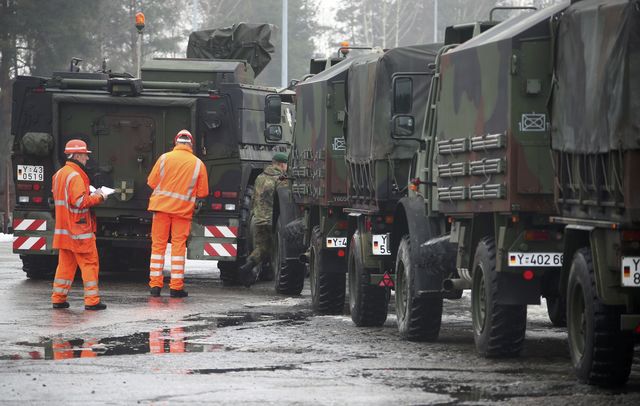Germany sends tanks to Lithuania for NATO mission
 German armed forces Bundeswehr vehicles in Grafenwoehr, Germany January 31, 2017, before deployment for NATO duty in Lithuania. (Photo: Reuters)
German armed forces Bundeswehr vehicles in Grafenwoehr, Germany January 31, 2017, before deployment for NATO duty in Lithuania. (Photo: Reuters) Germany has begun sending tanks and other equipment to Lithuania as part of a NATO mission to beef up the defence of eastern Europe and send a signal of resolve to Russia, which has denounced the build-up as an act of aggression.
The German army command said it was sending about 200 vehicles, including 30 tanks, by train to Lithuania along with 450 troops, the first of whom arrived last week. The transports would continue until late February.
Seven decades after the end of World War Two, the movement of German troops to eastern Europe, even on a NATO mission, remains a sensitive issue both in Germany and the region.
On Monday the US military deployed thousands of soldiers and heavy weaponry to Poland, the Baltic states and southeastern Europe in its biggest build-up since the Cold War.

German armed forces Bundeswehr soldiers prepare their vehicles in Grafenwoehr, Germany January 31, 2017, before deployment for NATO duty in Lithuania. (Photo: Reuters)
The movements are part of a strategy agreed by NATO leaders last July to reassure member states that were once part of the Soviet bloc and have been alarmed by Russia’s seizure of the Crimean peninsula from Ukraine in 2014.
The 28-nation Western alliance decided to move four battalions totalling 3,000 to 4,000 troops into northeastern Europe on a rotating basis to display its readiness to defend eastern members against any Russian aggression.
The deployments focus on Poland and the Baltic states of Estonia, Latvia and Lithuania, which fear Moscow could try to destabilise them by cyber attacks, territorial incursions or other means.
Russia denies such intentions and has described NATO’s behaviour as aggressive and threatening.
In early January, hundreds of US tanks, trucks and other military equipment arrived by ship in Germany to be transported by rail and road to eastern Europe for use by US troops being deployed under the NATO plan.
– Reuters


